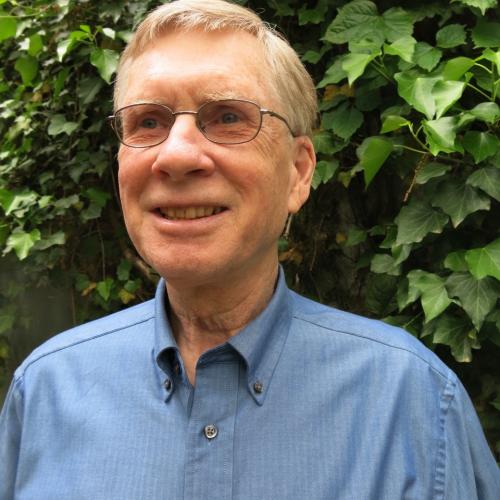
Neighborhoods are key to sustainable future
Safeguarding the environment—largely by designing and operating buildings and communities more wisely than we’ve done for the past 200 years—is the most crucial endeavor the Earth’s inhabitants are now engaged in. If we fail, not only will the weather turn more deadly. Many species will die out, food production will be disrupted, and humans will face conditions far harsher than those we experience today.
Chicago architect and urban designer Douglas Farr has a keen understanding of what’s at risk. His ambitious new book aims to help everyone—but particularly urban designers, architects, planners, and engaged citizens—grasp the complex challenge and steer civilization away from danger.
The 400 oversize pages of Sustainable Nation: Urban Design Patterns for the Future define the threat through a deeply researched text and a revealing set of graphs, charts, tables, building and site plans, photos, and other images. As most New Urbanists know, Farr has been focusing on sustainable living for a long time. He chaired the LEED for Neighborhood Development (LEED-ND) initiative, and in 2007 he wrote Sustainable Urbanism: Urban Design With Nature—a book he described at the time as “a first draft, destined to be written over and over as our collective knowledge, achievements, and sense of urgency increase.”
In this successor volume (longer and more visually dynamic than the 2007 book), he presents sustainability as something akin to a giant puzzle—a puzzle that consists of, or is affected by, many different factors. Farr examines a broad range of trends, patterns, and relationships that support a sound global ecology or that undermine it. Among the factors he documents are: global poverty (widespread but declining); inequality (rising); carbon dioxide emissions (rising); threatened species (ranging from 54 in Antarctica to 4,000 in Europe, to more than 13,000 in Asia); coal, oil, and gas reserves (much of which should be left in the ground); municipal solid waste (254 million tons are generated in the US each year); and renewable energy (rapidly growing and ever more cost-competitive).
Encouraging signs
I had expected that an environmental book would necessarily be gloomy. To my surprise, Farr identifies favorable trends as well as negative ones. At one point, he says “there is no better time to be alive than today. Incredible progress has been made on seemingly unsolvable global problems such as poverty, disease, and even climate change.”
The charts he’s assembled show:
• The rate of extreme poverty in developing countries plummeted to 14 percent in 2015 from 47 percent in 1990.
• In the same period, the number of children dying before the age of 5 fell to 6 million from 12.7 million.
• Since 1990, 1.9 billion people have gained access to piped drinking water—a major advance for public health.
• Education has surged; the number of the world’s children not enrolled in primary school dropped to 57 million from 100 million between 2000 and 2015.
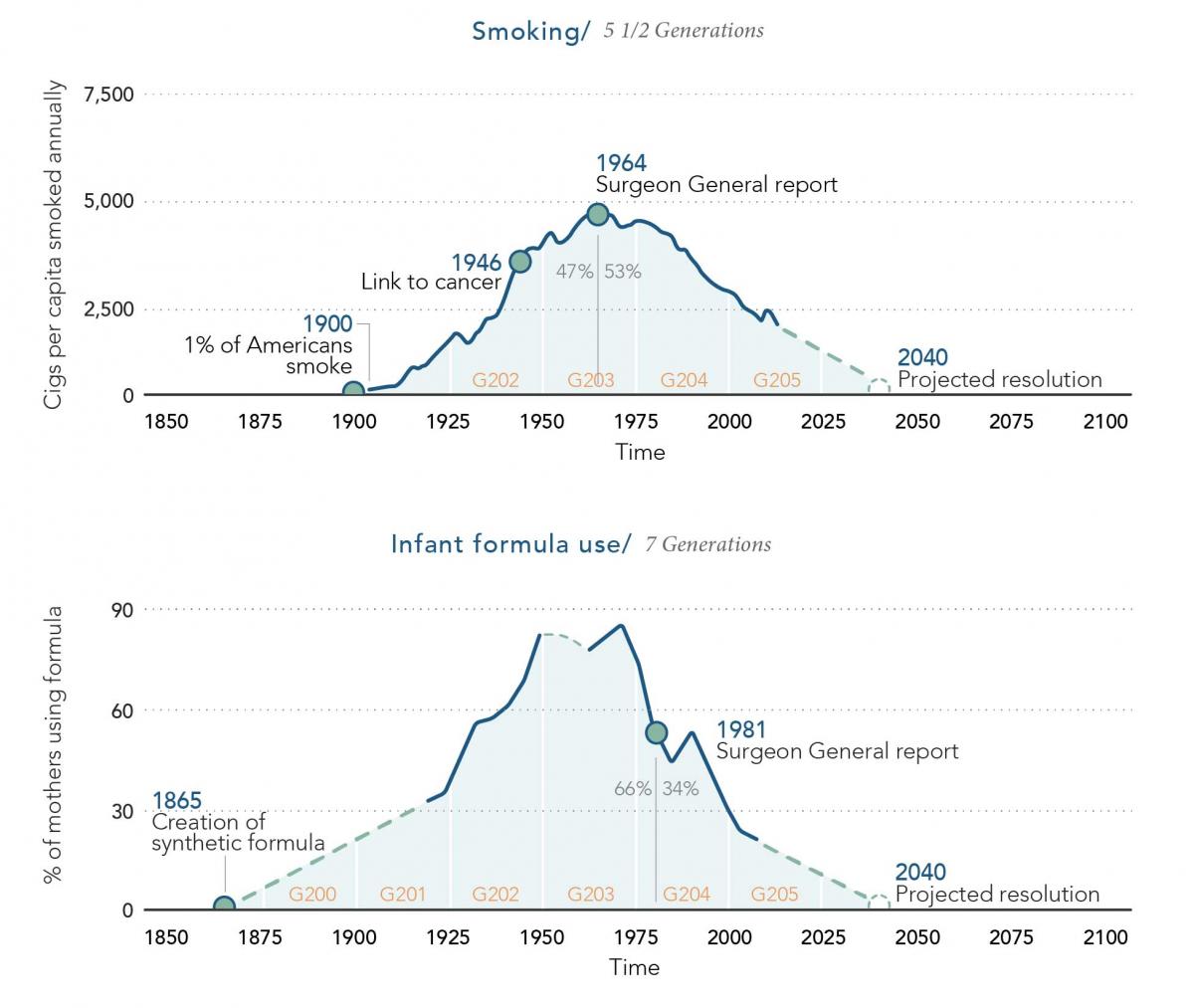
Despite such progress, the ecological challenge remains daunting. Farr, a methodical thinker, concludes that to develop solutions, we have to find out how long it will take—in years, decades, or generations—to surmount each of the major barriers to sustainable living. Knowing how much time will be required to overcome a particular problem—and what the effects of that problem are—can help officials, urban designers, and aroused citizens figure out which problem to attack first.
Carbon first
In the US, Farr finds that well-being is threatened most severely by three factors: “carbon pollution, obesity, and sprawl.” Of these three, it is carbon that must be tackled first, he asserts, because 1) it poses an existential threat and because 2) the longer we wait, the higher the costs will be.
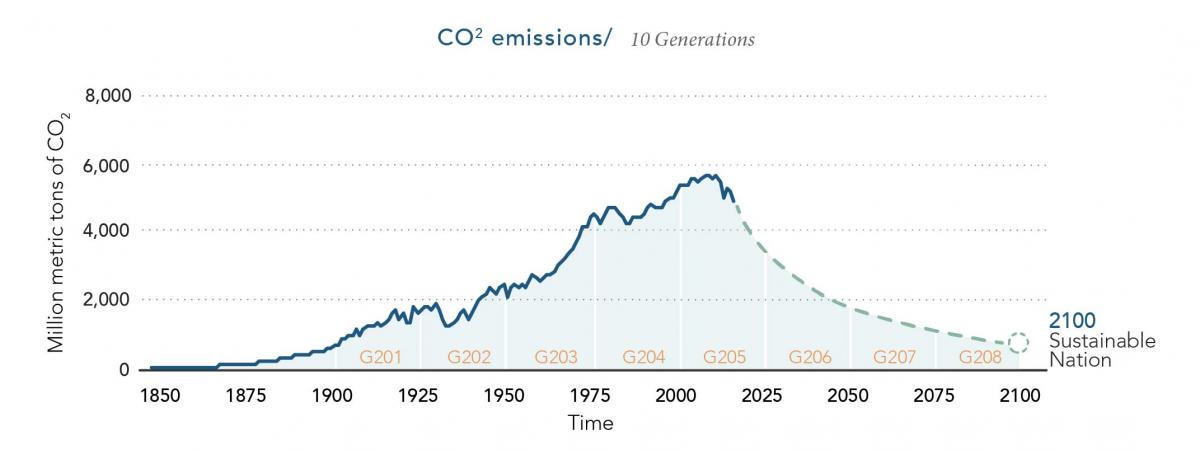
Carbon emissions have been the target of a movement called Architecture 2030, which was founded in 2002 with the goal of making all new buildings and major renovations in the US “net-zero-energy” by 2030. The improvements advocated by Architecture 2030 are meant to make buildings so efficient that these structures will not add even slightly to global warming. The aim is to prevent the Earth’s temperature from rising more than 2 degrees Celsius.
Sadly, the 2030 timetable is already receding out of reach. Says Farr: “By all reports, there is no chance of reducing United States CO2 production 80 percent by 2030; however, there is every chance of doing so in the twenty-first century. And all agree on this much: the sooner the better.”
Creating walkable neighborhoods
Farr is not optimistic about reversing sprawl, at least in the short term. Only 14 percent of US neighborhoods currently qualify as “walkable,” meaning that their residents can accomplish most of their daily or weekly errands on foot. Eighty-six percent of American neighborhoods remain automobile-dependent. Farr proposes a long-term, incremental goal—that two-thirds of urbanized places should be made walkable by 2100. The best way of doing that, he says, is to adopt walkable subdivision and zoning codes and direct new development to infill locations.
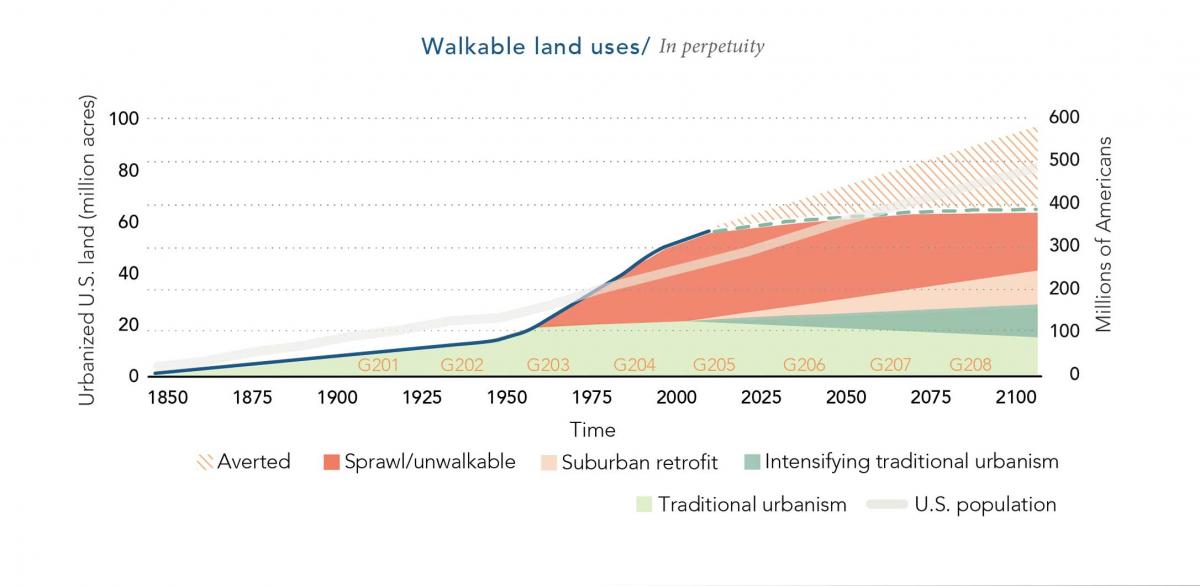
Farr doesn’t say much about what national governments or world organizations might do. Maybe this reflects the dismal reality that at the national level, the US and many other countries are now in a reactionary phase—emotionally dead-set against greater international cooperation. In any event, Farr argues that “each nation and culture has a unique starting point” and “consequently, each people or nation has to embrace unique, locally attuned strategies and solutions.”
That, according to Farr, means that progress on a global scale requires a multitude of largely local actions. To be effective, those actions must be carefully formulated and must be carried out in a sequence that builds momentum. He recommends that local groups follow this sequence: Step 1: Define the status quo (such as: 12 percent rate of the neighborhoods trips are made on foot rather than in a car). Step 2: Define success (raising the level of walk trips 40 percent in 25 years). Step 3: Identify stages of progress.
The stages of progress might come in a progression like this: Year 1, build social capital. Year 2, start a conversation by visiting “pilgrimage sites” (places that embody a relevant ideal—Charleston, South Carolina, for example, or Vancouver, Canada). Year 3: pilot ideas. Years 3 to 25: nudge behaviors by launching a walk-to-school effort and other campaigns. Years 3 to 25: achieve built changes. Altogether, these comprise about half of the overall sequence that Farr recommends.
I’ve been involved in some community efforts where I live, in New Haven, Connecticut, and I have to say that they bore little resemblance to Farr’s system. Most small groups, in my experience, don’t have the capacity to project so far ahead. They are motivated mostly by specific threats—problems so urgent that they send a surge of adrenaline through the community. The adrenaline is critically important, but its longevity is limited.
But even if Farr’s “theory of change” is based on highly optimistic reading of local capabilities, it’s stimulating to see how he views things. Some groups—maybe many groups—may be able to tailor Farr’s program to their own circumstances and achieve tremendous progress. He maintains that his system can transform “a sprawling nation into a walkable nation in four generations (100 years), one neighborhood at a time.”
Farr’s hope, though, is that in many places, things can be turned around much faster. Not only is this possible, he says; it can be done without harming the economy. California, he points out, cut the per-capital carbon intensity of its economy by 17 percent from 2000 to 2012—while its gross domestic product galloped forward by 19 percent.
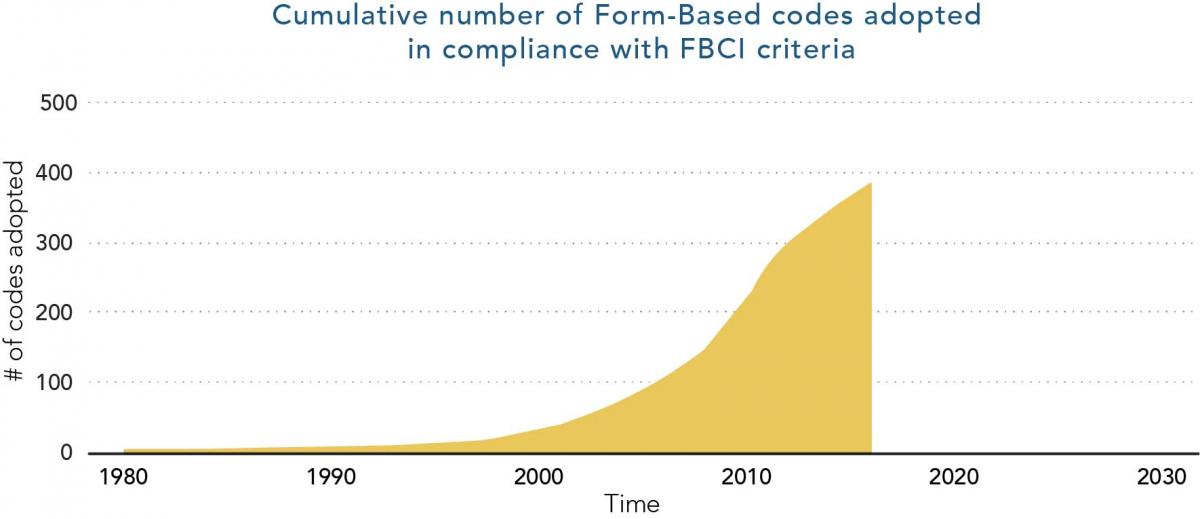
Weaknesses
Sustainable Nation has a split personality. The book promises to be a guide to action, which depends on brevity and conciseness, but it is almost encyclopedic in scope. The book covers so many topics, often in detail, that it’s lengthier than most readers’ attention spans. It introduces terms and phrases that will may be unfamiliar: “communities of practice,” “networks of practice,” “Berlin.” (Farr defines a Berlin as “a concise, measurable, and agreed-on end state” for a series of intended changes; he bases it on General Eisenhower’s use of the fall of Berlin as a measure of the Allies’ success during World War II.)
Acronyms abound. Health, safety, and welfare are abbreviated as “HSW.” Theory of Change is “TOC.” “Networks of practice” are “NoP.” Though always interesting, some of the book’s charts seem a bit remote from the book’s main purpose.
The book says almost nothing about the world’s population explosion, which Westerners have long been told is a looming threat. “The concentration of global population growth in the poorest countries presents a considerable challenge to governments in implementing the 2030 Agenda for Sustainable Development,” the United Nations warned exactly one year ago.
Farr notes that by 2050 the population will reach 389 million in the US, 399 million in Nigeria, over 1.3 billion in China, and 1.7 billion in India. The Earth’s population, which climbed to 5 billion only in 1987, is projected to reach 9.8 billion in 2050 and 11.2 billion in 2100. I would have thought population growth—and methods for tempering in the birth rate—would fill many of these pages. Even in a book geared primarily to local actions, this constitutes a major oversight.
A cornucopia of instruction
Whatever its flaws, Sustainable Nation is a conscientious and extremely generous compilation of ideas, techniques, and model projects that can make the world a better place. The first half of the book includes a sizable number of case studies from the author. Some focus on communities—such as a development near Malmo that implemented Sweden’s sustainable development principles. Some examine buildings—like the University of British Columbia’s Centre for Interactive Research on Sustainability, whose frame made of timber sequesters more carbon than was spent in constructing the building. The case studies are rich in detail.
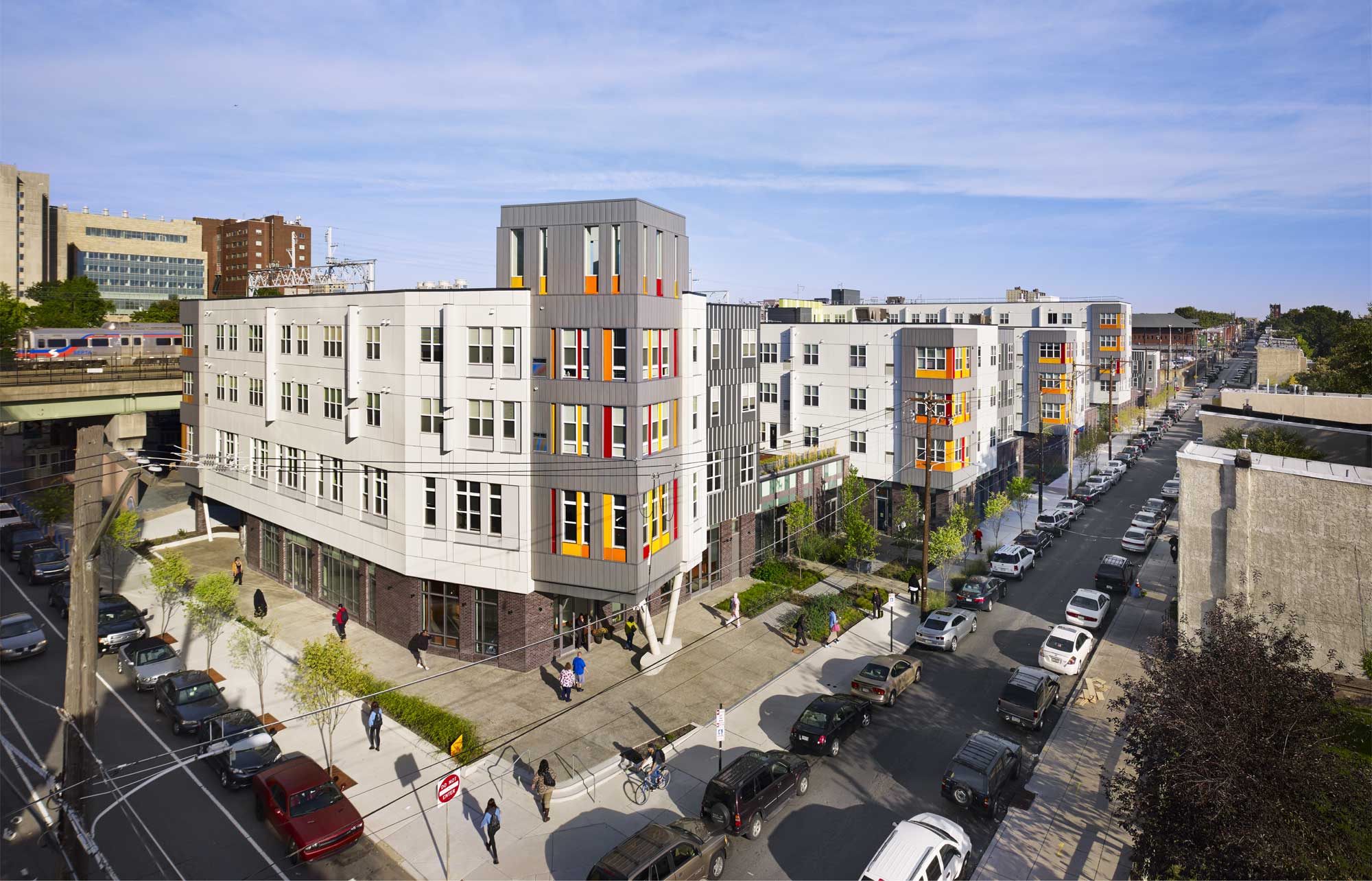
The case studies are rich in detail. In Philadelphia, he looks at Paseo Verde, a mixed-income, transit-oriented development praised for “its marriage of social and environmental sustainability.” That project—a collaborative effort of Jonathan Rose Companies, architects Wallace Roberts & Todd, and Association of Puerto Ricans on the March, a North Philadelphia community development corporation—provides just 67 parking spaces for its 120 apartments. There’s more parking for bicycles than for cars. Staircases have been placed closer to the building entrances than the elevators are—thus encouraging physical activity and consuming less electricity. Paseo Verde’s sustainable features are designed to serve multiple functions; a green roof serves as a garden courtyard.
The second half of the book is made up of case studies prepared by more than 70 contributing authors. Most of these are limited to two pages each. In a short space, they convey an impressive amount of information. The studies are arranged into chapters on a variety of topics: How to build trust and thus encourage change. “Vibrant density.” Urban waters. Stranded carbon. “The new health, safety, and welfare.”
Fred Kent of Project for Public Spaces floats the idea that “to be successful, communities of all sizes need at least 10 destinations—places where people want to be, and which give an identity and image to their communities.” Mary Nelson of Bethel New Life, a faith-based community development organization on Chicago’s West Side, dispenses tips on how to organize a community. Kareeshma Ali of Chicago’s Greater Good Studio explains how to use participatory art to build social networks. Janine de la Salle of Urban Food Strategies in British Columbia looks at how to create a unique, visible food culture in a neighborhood. In all, the book’s second half contains 200 pages of handsomely illustrated case studies. It’s a intellectual feast for urbanists.
Farr and Sydney Blankers VanKuren, who runs Farr Associates’ sustainable urbanism enterprise—and who managed this incredibly complicated book project for him—have accomplished something extraordinary. Be sure to seek it out.
Sustainable Nation: Urban Design Patterns for the Future by Douglas Farr—Wiley, 400 pp., $80 hardcover, $80 e-book.




